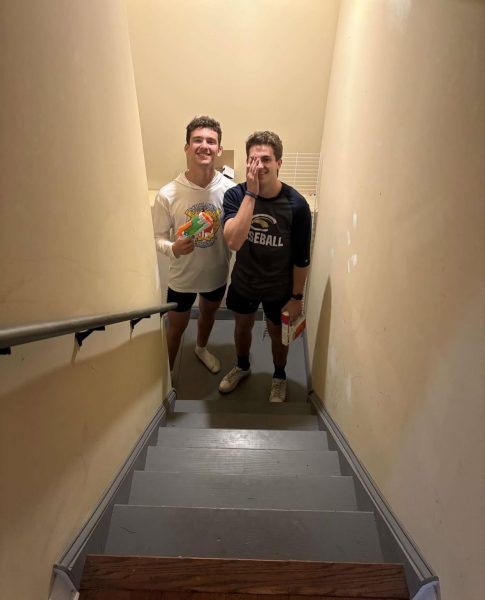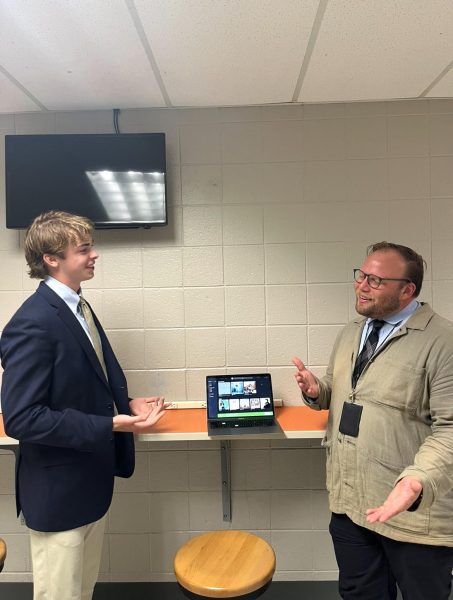AP teachers and students on new “term” schedule and effects of virtual learning
With Malvern’s new half-a-semester-long “term” schedule, some teachers need to adapt by remodeling the structure of their courses.
When Malvern closed campus in March in favor of virtual learning, many classes had to adapt in order to efficiently teach the remaining lessons in the school year. This especially applied to Advanced Placement (AP) classes, which have exams in May to determine if students will receive college credit.
For AP Calculus teacher Mr. Tom Pannulla, ensuring that students stayed connected with him was a top priority, along with figuring out a new way to teach.
“I had to figure out how I was going to connect with the students and then also deliver the content in a different way,” Pannulla said. “Last spring, I did not have a whiteboard or any space at home to teach how I’m teaching right now.”
With a lack of teaching space at home, Pannulla had to improvise in order to effectively deliver the remaining lessons.
“I had to create videos, based off of PowerPoints that I created,” Pannulla explained. “It took a huge amount of preparation to build those slideshows every day for class–it was more than I would have typically done for any class in total.”
However, Pannulla was also committed to connecting with students in-person.
“There’s that connection with the students piece,” Pannulla said, “so what I did was at the very beginning of each class, I would make sure to have at least ten or so minutes with the students to check in and see how they were doing.”
Alongside virtual learning, Malvern has adopted a new “term” schedule that allows students to take four courses over a two-month period. Many AP classes had to restructure in order to fit their large amounts of content within two two-month terms.
Pannulla believes there are both ups and downs to the new schedule, with the best change being communication with students.
“The good news is that we’re able to be in school,” Pannulla said, “so the structure of communication has changed because now I’m able to deliver content live as opposed to via videos.”
While classes may only meet four times a week, Pannulla thinks that the consistency in seeing his classes has led to better performance.
“One of the nice things about the schedule is that there is more consistency with seeing students on a weekly basis,” Pannulla said. “Seeing a student four times a week in our old schedule was a rarity–now it’s consistent, so you’re able to build on concepts a lot easier.”
Malvern has also prepared teachers in the event that there is an outbreak of COVID-19 and the school has to go fully virtual.
“Malvern has helped with this, but it’s improvements at home,” Pannulla said. “All the teachers got these big monitors which really helps with seeing your students, and it is actually huge to see their facial expressions and to see who’s talking and to just see them as naturally as you possibly can.”
Alex Zavalny ‘21 is in his third year of taking AP classes, and with that rigorous experience, he disagrees with the new schedule.
“This is my third year taking AP classes,” Zavalny said, “and we can all agree that the new term schedule has been a dramatic shift—one that I personally don’t agree with.”
Zavalny thinks that the new schedule doesn’t allow enough time for the enormous amount of AP content to be taught to students.
“AP courses have always been designed to be taught throughout the course of a school year,” Zavalny said, “and when you cram content into a pair of two month-long terms, you can’t go in depth with a lot of the material.”
However, Zavalny believes that AP teachers have been doing the best they can to deliver as much content as possible.
“I’ve seen our AP teachers do the best they can with the time they’re given,” Zavalny said. “In my [AP Calculus] BC class, we got through 40% of the material quite successfully by the end of the first term. Although taking tests as a class in the tent outside Stewart is annoying, Mr. Pannulla makes the class engaging by assigning us group FRQs (Free Response Questions) and quizzes.”
On the contrary, courses that fully utilized computers for their content haven’t been affected as much.
Dr. Kevin Quinn, who teaches AP Computer Science, thinks that his class hasn’t had as much of a knockback as other classes.
“It wasn’t a shock to the system for AP Computer Science in particular,” Quinn said. “The way that I’ve designed the courses is to have all of our material on a course website that I’ve built and used over the years.”
Quinn believes that since the course is a programming class, not being physically present wasn’t too big of a deal. Accordingly, he thinks that in the event of a COVID-19 outbreak, the transition to virtual classes will be a seamless process for his class.
“I certainly would prefer to work in the same physical space, but we don’t have to be in a workshop, or we don’t have to be using a pottery wheel,” Quinn said. “It was really kind of a hit the ground running in the spring and the same thing in the fall.”
Quinn also believes that consistency in the new schedule has helped his students.
“It’s nice because from a consistency standpoint, I really like having less courses that a student is focused on at a time,” Quinn said, “so instead of seven or eight different teachers that you’re working with, you only have three or four.”
Despite the boundaries surrounding classes at Malvern this year, AP teachers have demonstrated a commitment to both stay connected with students and deliver course content in an efficient manner.






